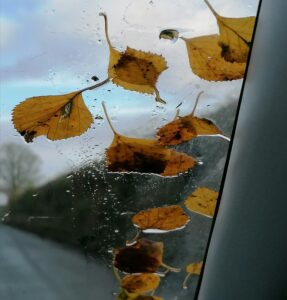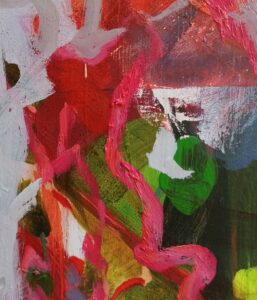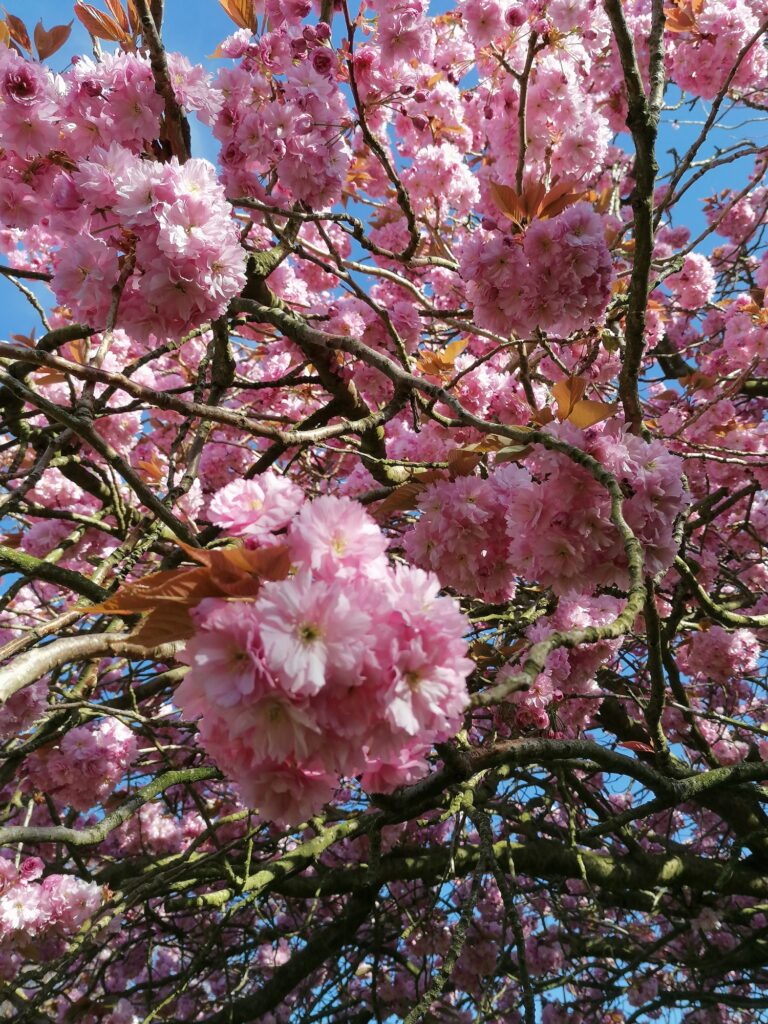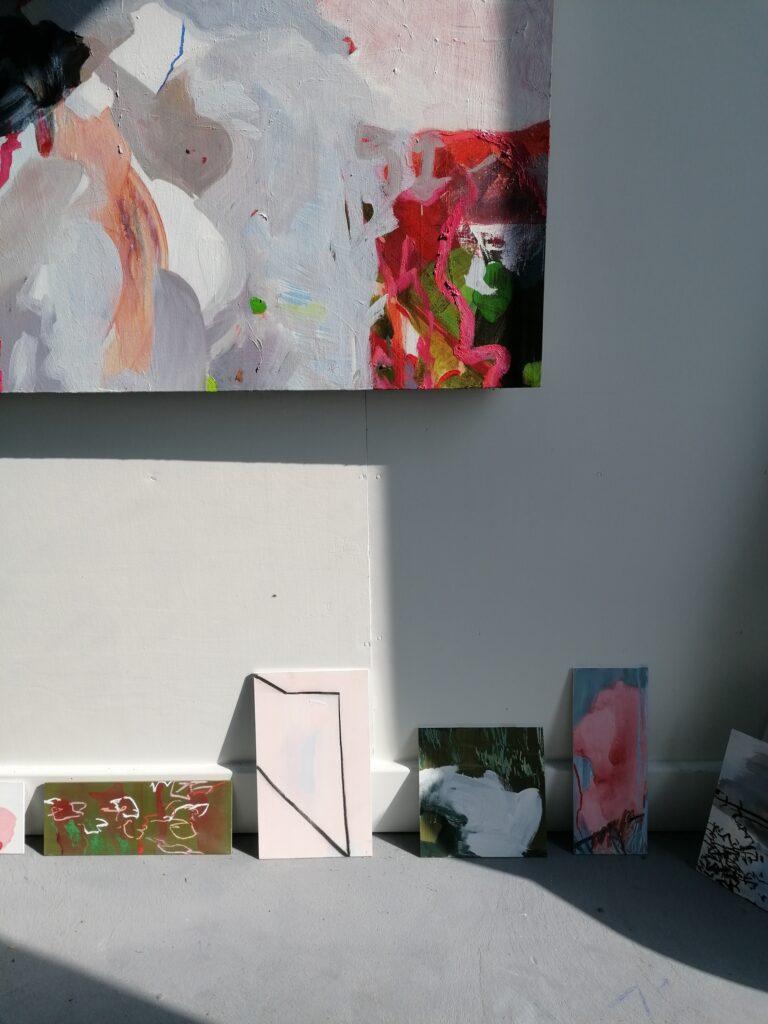To get to my studio I walk under an old cherry tree heavily laden with outrageously pink blossom at this time of year. I always slow down to savour the special pink light beneath it and when there’s a lively wind making the branches dance and collide it’s quite an operatic experience. Inevitably some of this comes with me into the studio. Petals stuck to the soles of my shoes of course, but also the magic pink tree experience reverberating in my head. This type of ‘cross fertilisation’ fascinates me. How the outside world of light and movement- things seen, heard, smelt, seep into paintings without invitation. I have been investigating this internal/external dynamic for years I now realise, and it is Hedda Sterne who has pointed this out to me. By researching her work I am learning to hone my focus and see the threads that run through my own work. She had laser beam clarity at times and used her painting practice (which included drawing, meditation, writing as well as painting) to achieve this. I am learning from her.

I am on with several things at once since my return from New York (as always!)-
-Transcribing Hedda’s studio notes that I saw at the Hedda Sterne Foundation. I am doing this slowly (and relishing the process)
-Making a set of paintings which respond to a series of Hedda’s drawings made in 1967
-Continued studio experiments – using oil on paper for these pieces
-I am drafting a research proposal (new territory altogether for me).
-Virginia Woolf has also joined in the creative conversation.
In my last post I mentioned meeting Mary Ann Caws, one of Hedda Sterne’s great friends who told me lots about their friendship. I did not explain quite how important my conversation with her was. She has set a million thoughts whizzing around my mind. Most importantly, about the nature of creative enquiry and the energy attached to creative fire in the belly. She told me about how they would often discuss Virginia Woolf (Mary Ann has written her biography). I am catching up on reading all of VW’s work as I go. Woolf’s ability to create new formats to suit her ideas, her recording of consciousness and her insights linking everyday ‘normal’ occurrences with a broader significance are all very relevant to Hedda’s ideas. Her observations about the ‘quality’ of consciousness resonate with Hedda’s studio notes, I think. Images here of a sequence of paintings emerging, inspired by a set of Hedda Sterne’s drawings made in 1967. Click on each one for full image.
Meanwhile my small studio drawings are forming clans…building up their numbers in a sunny corner of the studio and starting to exert their will on the larger canvases. A fine example of the mystery of painting practice. I have started to realise that images or objects on the periphery of vision are important in the studio and have begun to explore this potential. So one wall has writing, interesting quotes and images from newspapers, scribbled down from the radio, or written quotes, lines of poetry etc. Another has photocopies of some of Hedda’s drawings which I am using as the basis for a body of work at present. The other walls have my own small (or large) paintings and drawings and flowers… I always have some flowers on my painting table.
Those little drawings on board propped up against the wall- I’m realising that the gap between the cluster of boards and the painting above is charged space- like the invisible magnetism between dancers- it is a space alive with interaction. I wonder why and how? This seems to point to brain workings again- visual and cognitive links. I am reminded of something artist Patti Trimble (Hedda’s studio assistant for ten years) told me about Hedda’s studio. She used to be given the job of painting the floor white. I was astonished when she told me this; thinking of the mess on my own studio floor, which at times descends into a sticky, textured mass, let’s be honest. Anyway, I decide to try it out. Just on a strip in the chatty corner where the little pictures jostle and nudge each other for now. A few of these small drawings on board here.
I never imagined this research would lead to painting a section of floor white, but needs must! Suddenly, it’s important to examine this space between images. I wonder if the invisible interaction taking place will be easier to see if wall and floor are white. I also rearrange these little drawings on board often- sometimes turning them around and bunching them together in new ways. These arrangements (a bit like changing tempo) are surprisingly illuminating. Like choreography or curation, they help to highlight different aspects of the larger paintings which are emerging at a slower pace.
Now, back to Sterne’s studio notes that I saw in New York. Shaina Larrivee, Director of the Hedda Sterne Foundation, had explained to me in our first video call that Hedda had collected together some of her writing, photos, drawings etc into Manilla envelopes. I was very excited to see these. Not just for what they might contain but also for the fact that they represented Hedda’s own way of starting to archive her work. By her work I mean her thinking as well as her finished paintings. So, I include in that phrase her writing and ‘studio notes’, diaries (which are almost interchangeable with her other notes) as well as her paintings, drawings and prints. The first thing that struck me was the size of them. Bigger than I expected and squarer. American paper sizes are a little different than those in the UK, so their size and shape surprised me. Somehow their dimensions are important. I even went to a stationery store to buy one or 2 to remind myself how they are. Why does it matter? I’m not sure but it does to me- the link between physical object- scale, texture, weight, smell etc helps me to better place the words and thoughts they point to in my brain. Almost like a type of synaesthesia?
It is also important that the writing is usually on very thin paper, sperate sheets torn off a pad. Shaina showed me two large grey boxes full of Hedda’s studio notes- written mostly with quite large rapid script in biro or ink pen in a vertical format. Flowing thoughts. Occasionally Hedda revisits them. I am guessing rereading and altering words for clarity- possibly years later to ensure that the message is clear. To take this care in making sure her thinking is recorded and passed along feels like a deliberate handing over of knowledge and creative threads to unknown minds for use in the future. A real privilege to read them. There is so much wisdom contained in those boxes, they are a delight. The cheap, easy peel nature of the pad is key- a place to scribble down thoughts as they emerge- with no over thinking. This makes them a particularly interesting record of thinking. Not being in sentences or in any sequence is also important, it places them outside of time. Shaina explained to me that she decided to catalogue them like poetry, by using their first lines. I love that they are ordered like poetry. This is entirely appropriate. Laura Cumming has it right when she says of Hedda’s studio notes ‘Someone should publish Sterne’s every utterance, one day, as inspiration for the whole human race.’
Reading them in the large, bright space of the Hedda Sterne Foundation, they are like a companion text to her drawings and the beautiful display of work hung in the space. Those pictures too, make delicate links and connections across time. The whole is a pristine tapestry of intricate high level thought processes. (Virginia Woolf would approve of Hedda’s ‘quality of consciousness’). They amply point to the many ‘facets of reality’ Hedda was fascinated by. A truly marvellous and frankly awe-inspiring collection of a great mind recording and questioning of self.
















